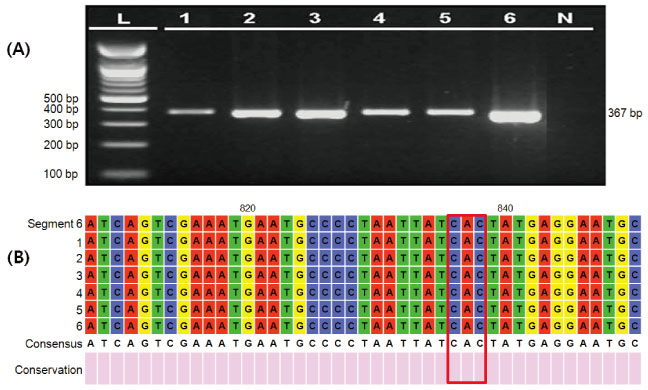Infect Chemother.
2010 Aug;42(4):257-261. 10.3947/ic.2010.42.4.257.
Three Reinfection Cases of the Pandemic Influenza (H1N1 2009)
- Affiliations
-
- 1Department of Internal Medicine, Kangwon National University College of Medicine, Chuncheon, Korea. wsoh@kangwon.ac.kr
- 2Department of Emergency Medicine, Kangwon National University College of Medicine, Chuncheon, Korea.
- 3Department of Laboratory Medicine, Kangwon National University College of Medicine, Chuncheon, Korea.
- 4Department of Cardiothoracic Surgery, Kangwon National University College of Medicine, Chuncheon, Korea.
- KMID: 1457389
- DOI: http://doi.org/10.3947/ic.2010.42.4.257
Abstract
- Infection with influenza virus results in acquisition of immunity, preventing reinfection with the homologous virus. Although reinfection following primary infection is rare, its incidence depends on immunity of human body, antigenic diversity of influenza virus, and the presence of outbreak in the community. During the pandemic influenza (H1N1 2009), a child and two women were reinfected by H1N1 influenza virus several weeks after the primary infection, and they were successfully treated again by oseltamivir. This case series will provide additional information on diagnosis, treatment, and prevention of the pandemic influenza (H1N1 2009).
MeSH Terms
Figure
Reference
-
1. Zimmer SM, Burke DS. Historical perspective-Emergence of influenza A (H1N1) viruses. N Engl J Med. 2009. 361:279–285.
Article2. Treanor JJ. Mandell GL, Bennett JE, Dolin R, editors. Influenza virus. Principles and practice of infectious diseases. 2005. 6th ed. New York: Elsevier Churchill Livingstone;2060–2085.3. Sonoguchi T, Sakoh M, Kunita N, Satsuta K, Noriki H, Fukumi H. Reinfection with influenza A (H2N2, H3N2, and H1N1) viruses in soldiers and students in Japan. J Infect Dis. 1986. 153:33–40.
Article4. Perez CM, Ferres M, Labarca JA. Pandemic (H1N1) 2009 reinfection, Chile. Emerg Infect Dis. 2010. 16:156–157.
Article5. Kim BN, Kwak YG, Moon CS, Kim YS, Kim ES, Bae IG, Yeom JS, Lee CS. Trend in Age Distribution of Visitors to Fluclinics during the Pandemic Influenza (H1N1 2009). Infect Chemother. 2010. 42:90–94.
Article6. Carrat F, Vergu E, Ferguson NM, Lemaitre M, Cauchemez S, Leach S, Valleron AJ. Time lines of infection and disease in human influenza: a review of volunteer challenge studies. Am J Epidemiol. 2008. 167:775–785.
Article7. Aoki FY, Boivin G. Influenza virus shedding: excretion patterns and effects of antiviral treatment. J Clin Virol. 2009. 44:255–261.
Article8. Treanor JJ, Hayden FG, Vrooman PS, Barbarash R, Bettis R, Riff D, Singh S, Kinnersley N, Ward P, Mills RG. US OralNeuraminidase Study Group. Efficacy and safety of the oral neuraminidase inhibitor oseltamivir in treating acute influenza: a randomized controlled trial. JAMA. 2000. 283:1016–1024.
Article9. Nicholson KG, Aoki FY, Osterhaus AD, Trottier S, Carewicz O, Mercier CH, Rode A, Kinnersley N, Ward P. Efficacy and safety of oseltamivir in treatment of acute influenza: a randomised controlled trial. Neuraminidase Inhibitor Flu Treatment Investigator Group. Lancet. 2000. 355:1845–1850.
Article10. Cao B, Li XW, Mao Y, Wang J, Lu HZ, Chen YS, Liang ZA, Liang L, Zhang SJ, Zhang B, Gu L, Lu LH, Wang DY, Wang C. National Influenza A Pandemic (H1N1) 2009 Clinical Investigation Group of China. Clinical features of the initial cases of 2009 pandemic influenza A (H1N1) virus infection in China. N Engl J Med. 2009. 361:2507–2517.
Article11. Gomes MG, White LJ, Medley GF. Infection, reinfection, and vaccination under suboptimal immune protection: epidemiological perspectives. J Theor Biol. 2004. 228:539–549.
Article12. Gökaydin D, Oliveira-Martins JB, Gordo I, Gomes MG. The reinfection threshold regulates pathogen diversity: the case of influenza. J R Soc Interface. 2007. 4:137–142.
Article


